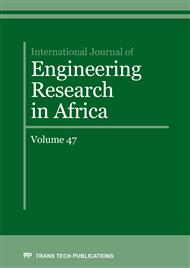[1]
A. A. Abdelrahman, N. M. Nofel, A. H. Ghallab, T. H. El-Afandy, and A. Mahmoud, Behavior of pre-stressed concrete beams subjected to fire, HBRC Journal, vol.7 no. 2, (2011).
Google Scholar
[2]
X. Hou, W. Zheng, V. K. R. Kodur, Response Of Unbonded Pre-Stressed Concrete Continuous Slabs Under Fire Exposure, Engineering Structures Journal, vol 56, pp.2139-2148 (2013).
DOI: 10.1016/j.engstruct.2013.08.035
Google Scholar
[3]
M. Faruqi, M. S. Khan, Deflection behavior of a pre-stressed concrete beam reinforced with carbon fibers at elevated temperatures, Higher Education Press and Springer-Verlag GmbH Germany, part of Springer Nature, (2018).
Google Scholar
[4]
M. T. El-Mihilmy, Concrete Shear Strength Of Pre-stressed Beams, Journal Of Engineering And Applied Science, Faculty Of Engineering, Cairo University, Vol. 54, No. 3, Pp. 319-338, (2007).
Google Scholar
[5]
X. Xiong, G. Yao, Studies on the static behaviors of unbonded pre-stressed steel reinforced low strength concrete rectangular frame beams, Engineering Structures, 171, (2018).
DOI: 10.1016/j.engstruct.2018.02.007
Google Scholar
[6]
S. Cattaneo, F. Giussani, F. Mola, Flexural behaviour of reinforced, pre-stressed and composite self-consolidating concrete beams, journal of the Construction and Building Materials 36 ,826-837, (2012).
DOI: 10.1016/j.conbuildmat.2012.06.001
Google Scholar
[7]
O.F. Hussien, T.H.K. Elafandy, A.A. Abdelrahman, S.A. Abdel Baky, E.A. Nasr, Behavior of bonded and unbonded pre-stressed normal and high strength concrete beams, journal of the HBRC, 8, 239-251, (2012).
DOI: 10.1016/j.hbrcj.2012.10.008
Google Scholar
[8]
C. Vázquez-Herrero, I. Martínez-Lage, H. Vázquez-Vázquez, F. Martínez-Abella, Comparative study of the flexural behavior of lightweight and normal weight pre-stressed concrete beams, journal of the Engineering Structures, 56 ,1868-1879, (2013).
DOI: 10.1016/j.engstruct.2013.08.008
Google Scholar
[9]
J.S. Du, Francis T.K. Au, Enoch K.H. Chan, L. Liu, Deflection of unbonded partially pre-stressed concrete continuous beams, journal of the Engineering Structures, 118,89-96, (2016).
DOI: 10.1016/j.engstruct.2016.03.040
Google Scholar
[10]
V. R. Kodur, M. Dwaikat, A numerical model for predicting the fire resistance of reinforced concrete beams, Cement and Concrete Composites 30(5):431-443 (2008).
DOI: 10.1016/j.cemconcomp.2007.08.012
Google Scholar
[11]
C. Eamon, E. Jensen, Reliability analysis of pre-stressed concrete beams exposed to fire, Engineering Structures, 43 69–77, (2012).
DOI: 10.1016/j.engstruct.2012.05.016
Google Scholar
[12]
A. F. Hassan, non-linear FE analysis of simply supported steel beams with RC slab under elevated temperatures, Journal Of Engineering and Applied Science, Faculty Of Engineering, Cairo University, Vol. 56, No. 4, Pp. 381-397, (2009).
Google Scholar
[13]
J. Gales, L.A. Bisby, C. MacDougall, K. MacLean, Transient high-temperature stress, relaxation of pre-stressing tendons in unbonded construction, Fire Safety journal; 44:570–9, (2009).
DOI: 10.1016/j.firesaf.2008.11.006
Google Scholar
[14]
A.H. Badawy, M.S. El-Feky, A. Hassan, H. El-kady, L. M. Abd-El Hafez, Flexural Behavior of Unbounded Pre-stressed Beams Modified With Carbon Nanotubes Under Elevated Temperature, Civil Engineering Journal, Vol. 5, No. 4,(2019).
DOI: 10.28991/cej-2019-03091294
Google Scholar
[15]
W.Z. Zheng, Q. Hu, H.Y. Zhang, Experimental research on the mechanical properties of prestressing steel wire (fptk=1770N/mm2, d=5mm, low relaxation) at and after high temperature Journal of Building Structure;27(2):120–128 (2006).
Google Scholar
[16]
Y. Aimin, D. Yuli, G. Litang, Behavior of unbonded pre-stressed continuous concrete slabs with the middle and edge span subjected to fire in sequence, Fire Safety Journal 56 ,20-29(2013).
DOI: 10.1016/j.firesaf.2012.10.023
Google Scholar
[17]
S. Asamoto, K. Kato, T. Maki, Effect of creep induction at an early age on subsequent prestress loss and structural response of pre-stressed concrete beam, Construction and Building Materials 70 ,158-164(2014).
DOI: 10.1016/j.conbuildmat.2014.07.028
Google Scholar
[18]
X. Hou, W. Zheng, V. Kodur, H. Sun, Effect of temperature on mechanical properties of pre-stressing bars, Construction and Building Materials 61, 24-32 (2014).
DOI: 10.1016/j.conbuildmat.2014.03.001
Google Scholar
[19]
H. El-kady, A. M. Yasien, M. S. El-feky, M. E. Serag, Assessment of mechanical strength of nano silica concrete (NSC) subjected to elevated temperatures, Journal of Structural Fire Engineering, 10(1), 90-109, (2018).
DOI: 10.1108/jsfe-10-2017-0041
Google Scholar


